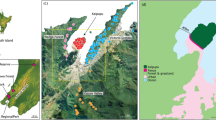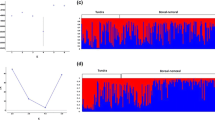Abstract
Genetic variability and structure were estimated by microsatellite analysis at 7 loci in brown rat populations (Rattus norvegicus) from the Iroise insular complex and neighbouring mainland (Brittany, France). Island genetic diversity is lower than on the mainland and a highly significant positive correlation was found between mean heterozygosity and the logarithm of island area, which is consistent with theoretical expectations. Rattus norvegicus populations are substructured at a kilometric scale, both on the islands and on the mainland. Intra-island structuration is extremely high, suggesting that no effective migration occurs between islands or with the mainland. Historical and genetical evidence suggest that R. norvegicus was introduced independently on Ouessant and Molène archipelago, with a low and a high founder effect respectively. These results are discussed in terms of recolonization probability of islands that have been cleared of R. norvegicus, which illustrates the usefulness of genetic markers in determining parameters of interest to the conservation biologist.
Similar content being viewed by others
References
Adler G andLevins R (1994) The island syndrome in rodent populations. The Quarterly Review of Biology 69(4): 473-490
Allen P,Amos W,Pomeroy P andTwiss S (1995) Microsatellite variation in grey seals (Halichoerus grypus) shows evidence of genetic differentiation between two British breeding colonies. Molecular ecology 4: 653-662
Atkinson I (1985) The spread of the commensal species of Rattus to oceanic islands and their effects on island avifauna. In: Moors P (ed) Conservation of island birds, International Council for Bird Preservation, Vol 3, pp 35-81, Cambridge, UK, I.C.B.P Technical Publication
Atkinson I (1989) Introduced animals and extinctions. In: Western D andPearl M (eds) Conservation for the Twenty-First Century. pp 54-79, Oxford University Press, New York
Audoin-Rouzeau F andVigne J-D (1994)La colonisation de l'Europe par le rat noir (Rattus rattus). Revue de paléobiologie 13(1): 125-145
Audoin-Rouzeau F andVigne J-D (1997)Le rat noir (Rattus rattus) en Europe antique et médiévale: les voies du commerce et l'expansion de la peste. Anthropozoologica 25-26: 399-404
Barrett-Hamilton G andHinton M (1912) A history of British mammals, Vol. 2. Gurney and Jackson, London
Beaucournu J-C (1995)A propos du vecteur de la peste en Europe occidentale au cours de la deuxième pandémie. Bulletin de la Société française de parasitologie 13(2): 233-252
Boursot P,Auffray J-C,Britton-Davidian J andBonhomme F (1993) The Evolution of HouseMice. Annual review of ecology and systematics 24: 119-152
Chapuis J-L,Barnaud G,Bioret F,Lebouvier M andPascal M (1994)L'éradication des espèces introduites, un préalable à la restauration des milieux insulaires. Cas des îles françaises. Nature-Sciences-Sociétés 2(3): 53-57
Cheylan G (1984)Le rat surmulot, Rattus norvegicus. In: Atlas des Mammifères sauvages. SFEPM et SFF, MNHN, Paris
Cheylan G andGranjon L (1987)Ecologie du rat noir a Lavezzi (Corse du sud): abondances, déplacements et reproduction. Travaux scientifiques du Parc naturel régional et des réserves naturelles de Corse 12: 71-91
Cheylan G,Granjon L andBritton-Davidian J (1998) Distribution of genetic diversity within and between Western Mediterranean island populations of the black rat Rattus rattus. Biological Journal of the Linnean Society 63: 393-408
Clark D (1981) Foraging patterns of black rats across a desert-montane forest gradient in the Galapgos islands. Biotropica 13: 182-194
Coblentz B (1990) Exotic organisms: a dilemma for conservation Biology. Conservation Biology 4: 261-265
Courchamp F,Langlais M andSugihara G (1999) Control of rabbits to protect island birds from cat predation. Biological Conservation 89: 219-225
Cramer D,Chakravarti A,Arenas O,Humprieres J andMowery P (1988) Genetic Diversity within and between Natural Populations of Rattus norvegicus. Journal of heredity 79: 319-324
Dallas J,Dod B,Boursot P,Prager E andBonhomme F (1995) Population subdivision and gene flow in Danish house mice. Molecular Ecology 4: 311-320
Daniel M andBaker A (1986) Collins guide to the mammals of New Zealand. Collins, Auckland, New Zealand
DelSal et al. (1989) The CTAB-DNA precipitation method: a common mini-scale preparation of template DNA from phagemids, phages or plasmids suitable for sequencing. BioTechniques 7: 514-521
Diamond J (1989) Overview of recent extinctions. In: Western D andPearl M (eds) Conservation for the Twenty-First Century, pp 37-41. Oxford University Press, New York
Diamond J andCase T (1986) Overview: introductions, extinctions, exterminations and invasions. In: Diamond J andCase T (eds) Community Ecology, pp 65-79. Harper and Row, New York
Du Tertre J-B (1667) Histoire générale des Antilles habitées par les français. Paris
Duval G,Lemajieu J,Michault A,Leroyer C,Vhuet C andGenin R (1988)La leptospirose humaine a l'île de la Réunion. A propos de 82 cas. Médecine et maladies infectieuses 2: 80-84
Eriksson K,Halkka O,Lokki J andSaura A (1976) Enzyme polymorphism in feral, outbred and inbred rats (Rattus norvegicus). Heredity 37: 341-349
Felsenstein J (1985) Phylogenies and the comparative method. American Naturalist 125: 1-15
Frankham R (1997) Do island populations have less genetic variation than mainland populations? Heredity 78: 311-327
Gaggiotti O,Lange O,Rassmann K andGliddons C (1999) A comparison of two indirect methods for estimating average levels of gene flow using microsatellite data. Molecular Ecology 8: 1513-1520
Giot P-R (1990)Le niveau de la mer: changeant, fluctuant, mouvant. Bull. Inf. A.M.A.R.A.I., Lab. Anthropologie et Préhistoire. Univ. Rennes I 3: 5-16
Golvan Y,Combes C,Euzéby J andSalvat B (1981)Enquête épidémiologique écologique sur la schistosomose à Schistosoma mansoni en Guadeloupe (Antilles Françaises). In: Mémoires du M.N.H.N., Vol. 119 of Série A Zoologie. p. 229. Museum, Paris
Goursaud R andPérez J-M (1993)Les leptospiroses en Guadeloupe. Résultats préliminaires d'une étude prospective. 5ème journée thématique de biologie médicale, Pointe à Pitre
Granjon L andCheylan G (1989)Le sort des rats noirs (Rattus rattus) introduits sur une île, révélé par radio-tracking. Comptes rendus de l'Académie des Sciences, série III 309: 571-575
Guo S andThompson E (1992) Performing the exact test of Hardy-Weinberg proportion for multiple alleles. Biometrics 48: 361-372
Jacob H et al. (1995) A genetic linkage map of the laboratory rat, Rattus norvegicus. Nature Genetics 9: 63-69
Jacobs L andPilbeam D (1980) Of mice and men: fossil-based divergence dates molecular clocks. Journal of Human Evolution 9: 551-555
Jourdane J andImbert-Establet D (1980)Etude expérimentale de la permissivité du rat sauvage (Rattus rattus) de Guadeloupe à l'egard de Schistosoma mansoni Hypothèse sur le rôle de cet hôte dans la dynamique des foyers naturels. Acta tropica 37: 41-51
Juminer B,Borel G,Mauléon H,Durette-Desset M-C,Raccurt C,Roudier M,Nicolas M andPerez J (1993)L'infestation murine naturelle par Angiostrongylus costariensis (Morera and Céspédes, 1971) à la Guadeloupe. Bulletin de la Société de pathologie exotique 86: 1-4
Kaiser G andTaylor R (1995) Rat extermination. Aliens
King C (1984) Immigrant killers. Oxford University Press, Auckland, New Zealand
Klöting I,Voigt B andKovacs P (1997) Comparison of genetic variability at microsatellite loci in wild rats and inbred rat strains (Rattus norvegicus). Mammalian Genome 8: 589-591
Lindsey J (1979) Historical foundations in the laboratory rat. In: Baker H,Lindsey J andWeisbroth S (eds) The Laboratory Rat, pp 35-81. Academic Press, New York
Mac Arthur R andWilson E (1967) Island Biogeography. Princeton University Press, Princeton, New Jersey
MacFarland C,Villa J andToro B (1974) The Galapgos giant tortoises Geochelone elephantopus. Part 1: status of the surviving populations. Biological Conservation 6: 118-133
Meads M,Walker K andElliott G (1984) Status, conservation and management of the land snails of the genus Powelliphanta (Mollusca: Pulmonata). New Zealand Journal of Zoology 11: 277-306
Menotti-Raymond M andO'Brien J (1995) Evolutionary conservation of ten microsatellite loci in four species of Felidae. Journal of Heredity 86: 319-322
Moors P andAtkinson I (1984) Predation on seabirds by introduced animals, and factors affecting its severity. In: Croxal J,Evans P andSchreiber R (eds) Status and Conservation of World' Seabirds, Vol 2, pp 667-690, I.C.B.P Technical Publication, Cambridge, UK
Nadeau JH (1999) Rattus norvegicus and the industrial revolution. Nature Genetics 22: 3-4
Nei M (1978) Estimation of average heterozygosity and genetic distance from a small number of individuals. Genetics 89: 583-590
Palmer M andPons G (1996) Diversity in Western Mediterranean islets: effects of rat presence on a beetle guild. Acta oecologia 17: 297-305
Pascal M (1995)Rapport du contrat INRA/Conseil général du Finistère sur les travaux réalisés dans le cadre de l'étude sur l'éradication du surmulot dans l'Archipel de Ouessant et de Molène. In: Iles, vivre entre ciel et mer. Rennes-Brest, p 4
Pascal M (1997a)Echec à la colonisation: ce n'est pas faute d'avoir essayé! In: Iles, vivre entre ciel et mer. MNHN and Nathan, Paris
Pascal M (1997b) Rapport de clôture de la première phase de l'opération d'éradication du surmulot (R. norvegicus) des îles de Trielen et l'Ile aux Chrétiens (Archipel de Molène), p 22
Pascal M andChapuis J-L (1999) Eradication of mammals introduced in the islands. In: Workshop on the Control and Eradication of Non-Native Terrestrial Vertebrates, Malta, 3-5 juin 1999, pp 23-34. Council of Europe, Strasbourg
Pascal M,Cosson J-F,Bioret F,Yésou P andSiorat F (1996a)Réflexions sur le bien-fondé de rétablir une certaine biodiversité de milieux insulaires par l'éradication d'espèces exogènes. Cas de certains Mammifères d'îles de Bretagne. Vie et Milieu, Life and Environment 46: 345-354
Pascal M,Siorat F andBernard F (1998) Interactions between norway rats and shrews in Brittany islands. Aliens
Pascal M,Siorat F,Cosson J-F andBurin des Roziers H (1996b)Eradication de populations insulaires de surmulots: archipel des Sept-Iles, archipel de Cancale, Bretagne, France. Vie et Milieu, Life and Environment 46: 267-283
Patton JL,Yang SY andMyers P (1975) Genetic and morphologic divergence among introduced rat populations (Rattus rattus) of the Galapgos archipelago, Ecuador. Systematic Zoology 24: 296-310
Raymond M andRousset F (1995a) An exact test for population differentiation. Evolution 49(6): 1280-1283
Raymond M andRousset F (1995b) GENEPOP (ver. 1.2): a population genetics software for exact test and ecumenicism. Journal of Heredity 86: 248-249
Roberts M (1991) Origin, dispersal routes and geographic distribution of Rattus exulans with special reference to New-Zealand. Pacific Science 45: 123-130
Sergov O (1972) Monomorphism of some structural genes in populations of wild and laboratory rats (Rattus norvegicus). Isozyme Bulletin 5: 58
Strobel M,De la Vareille B,Chevallier J,Cocquard J,Arnaud J,Lacave J,Daijardin J andGabriel J (1992)La leptospirose en Guadeloupe. Aspects cliniques, biologiques et épidémiologiques. Médecine et maladies infectieuses 22: 648-651
Swofford D andSelander R (1981) Biosys-1: a FORTRAN program for the comprehensive analysis for electrophoretic data in population genetics and systematics. Journal of Heredity 72: 281-283
Towns D andBallantine W (1993) Conservation and restoration of New Zealand island ecosystems. Trends in Ecology and Evolution 8: 452-457
Towns D,Daughterty C andAtkinson I (eds) (1990) Ecological Restoration of New-Zealand Islands, 2. Conservation Science Publication, Wellington
Vigne J-D andVillié P (1995)Une preuve archéologique du transport d'animaux par bateau: le crâne de Rattus norvegicus de l'épave du Ça ira (Saint-Florent, Haute-Corse, fin du 18è siècle). In: L'homme méditerrannéen, pp 411-416. Publ. Univ. Provence, Aix-en-Provence
Weir B (1990) Genetic data analysis. Sinauer Associates, Sunderland, Massachusetts
Weir BS andCockerham CC (1984) Estimating F-statistics for the analysis of population structure. Evolution 38: 1358-1370
Whitaker A (1973) Lizard populations on islands with and without polynesian rats, Rattus exulans (Peale). Proceedings of the New Zealand Ecological Society 20: 121-130
Williamson M (1997) Biological Invasions. Chapman & Hall, London
Wilson D andReeder D (1993) Mammal Species of theWorld. Smithsonian Institution Press, Washington, DC/London
Wilson P,Karl P,Toft B,Beggs J andTaylor R (1998) The role of introduced predators and competitors in the decline of Kaka (Nestor meridionalis) populations in New Zealand. Biological Conservation 83: 175-185
Wright S (1951) The genetical structure of populations. Annals of Eugenics 15: 323-354
Wright S (1965) The interpretation of population structure by F-statistics with special regard to systems of mating. Evolution 19: 365-420
Author information
Authors and Affiliations
Rights and permissions
About this article
Cite this article
Calmet, C., Pascal, M. & Samadi, S. Is it worth eradicating the invasive pest Rattus norvegicus from Molène archipelago? Genetic structure as a decision-making tool. Biodiversity and Conservation 10, 911–928 (2001). https://doi.org/10.1023/A:1016636512734
Issue Date:
DOI: https://doi.org/10.1023/A:1016636512734




